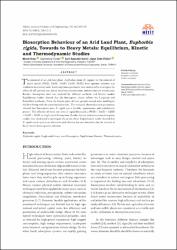Biosorption Behaviour of an Arid Land Plant, Euphorbia rigida, Towards to Heavy Metals: Equilibrium, Kinetic and Thermodynamic Studies
Abstract
T he potential of an arid-land plant, Euphorbia rigida (E. rigida), for the removal of heavy metals [Pb(II), Zn(II), Cu(II), Cd(II), Ni(II)] from aqueous solutions was studied in the current work. Batch sorption experiments were conducted to investigate the effects of pH, particle size, initial metal ion concentration, contact time and temperature. Besides, biosorption data was analysed by different isotherm and kinetic models. Equilibrium studies showed that the biosorption closely follows the Langmuir and Freundlich isotherms. From the kinetic point of view, pseudo-second order model gave the best fitting with the experimental results. The evaluated thermodynamic parameters showed that biosorption onto E. rigida was a feasible, spontaneous and endothermic process. The affinities of metal ions onto E. rigida decreased as Pb(II) > Zn(II) > Cd(II) > Cu(II) > Ni(II) in single metal biosorption. Besides, binary and ternary metal sorption studies were conducted to investigate the co-ion effect. Experimental results showed that E. rigida can be used as an alternative and effective low cost biosorbent for the removal of heavy metals from aqueous solutions T he potential of an arid-land plant, Euphorbia rigida (E. rigida), for the removal of heavy metals [Pb(II), Zn(II), Cu(II), Cd(II), Ni(II)] from aqueous solutions was studied in the current work. Batch sorption experiments were conducted to investigate the effects of pH, particle size, initial metal ion concentration, contact time and temperature. Besides, biosorption data was analysed by different isotherm and kinetic models. Equilibrium studies showed that the biosorption closely follows the Langmuir and Freundlich isotherms. From the kinetic point of view, pseudo-second order model gave the best fitting with the experimental results. The evaluated thermodynamic parameters showed that biosorption onto E. rigida was a feasible, spontaneous and endothermic process. The affinities of metal ions onto E. rigida decreased as Pb(II) > Zn(II) > Cd(II) > Cu(II) > Ni(II) in single metal biosorption. Besides, binary and ternary metal sorption studies were conducted to investigate the co-ion effect. Experimental results showed that E. rigida can be used as an alternative and effective low cost biosorbent for the removal of heavy metals from aqueous solutions
Source
Hittite Journal of Science and EngineeringVolume
4Issue
2URI
http://www.trdizin.gov.tr/publication/paper/detail/TWpjeE5UWTJOZz09https://hdl.handle.net/11421/21337
Collections
- Makale Koleksiyonu [179]
- TR-Dizin İndeksli Yayınlar Koleksiyonu [3512]


















